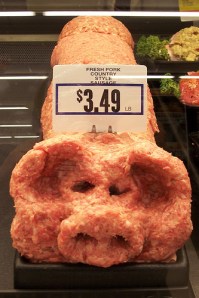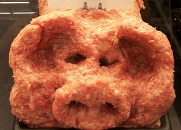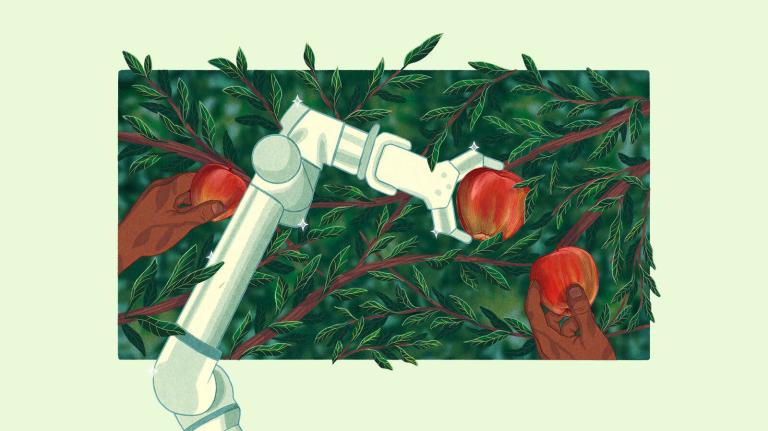
Photo by Teresia.
A recent New York Times op-ed declared that sustainable meat is a “myth.” Whether pastured, small-scale, large-scale, rotationally grazed, locavore, industrialized, etc., all meat is essentially the same and none of it is sustainable. So says author James McWilliams who points, as many have, to the climate impact of livestock production.
I take issue with some of McWilliams’ figures (for example, here’s the Environmental Working Group’s explanation of pastured meat’s reduced climate footprint), but by and large I agree! Meat production at its current scale — and the scale it’s projected to reach as the developing world increases its consumption — is not sustainable. Period.
New science arises nearly every month that points to the climate impact of meat eating. This week, it’s this study out of Woods Hole that connects the effect of nitrogen fertilizer on the atmosphere (as I mentioned last week, nitrogen turns into nitrous oxide, a potent greenhouse gas that was recently confirmed to be a significant source of climate change). The study concludes that, in order to avoid catastrophic climate change, we need to either cut global meat consumption or the amount of fertilizer we use in half (we’ll have more on the study on Grist soon). In other words, save this cow or the whole planet gets it!
So while I’m with McWilliams on his main assertion, I object to some of his lesser ones. He offers an extensive scolding to locavores and advocates of pasture-raised animals for missing this larger point. But he conveniently ignores the fact that his argument has much in common with those of Michael Pollan (with his “Eat food, not too much, mostly plants” mantra) and Mark Bittman (who is vegan before 6 p.m.). Both men talk and write extensively about the need to eat less meat while also changing the way we produce the meat we do eat.
Indeed, Bittman himself made that point repeatedly on a recent appearance on MSNBC’s Up with Chris show to debate pink slime — although pink slime has muddied these waters a bit. One of the other panelists on the show, Josh Barro of Forbes magazine, echoed Bittman, while also echoing the industry line that pink slime is part of the solution, rather than the problem. In his view, telling consumers about industrial food products like pink slime encourages them to “focus on the wrong things.”
Barro observed that consumers learn about pink slime and say, “Ew, that’s gross,” when the real problem is that “we’re eating too much meat.” He later said that consumers confront the realities of industrial agriculture and incorrectly ask, “Does this sound gross? And if it sounds gross then that’s a problem.”
Along those lines, host Chris Hayes opined that sausage is gross but “if you’re going to eat meat you should waste not want not, so we should distinguish between visceral revulsion and moral revulsion.” He went on to say that he sees moral revulsion being a better basis for drawing conclusions about the food system. They both make interesting points, but I would argue — since this is food we’re talking about — that it’s nearly impossible to separate the two. Because who wants to be grossed out by what you’re going to eat?
And yes, Americans are notorious for an unwillingness to eat anything but the choice cuts of meat — at least, when they know what they are. Most show little or no reluctance if it’s been ground, highly processed, and/or deep fried. But this tendency to flinch once you’ve seen the raw ingredients should not be confused with what is truly gross about pink slime — and that’s not just that it comes from the parts that would make people squeamish if they ate them straight off the animal.
No, what’s gross about pink slime is the fact that it’s a process that was developed to repurpose meat that was previously considered unfit for human consumption because of its high rate of pathogens. What they do to it is gross, yes — but it’s not the ammonia alone that’s the problem, either. It’s why they have to add ammonia that should make it unappetizing, particularly because they failed to tell us they were putting it in our burgers.
The huge error the industry made was trying to pass it off as true ground beef. In fact, the USDA whistleblower who coined the term pink slime observed that it technically fits the definition of something known as “beef-patty mix” — a meat additive. I think what kicked off the outrage wasn’t just pink slime itself (although the visceral gross-out factor is big), but the clear indication that the industry was trying to pull a fast one. We all know what ground beef is — and pink slime just isn’t ground beef.
But it’s also true that the broad use of pink slime lowered the cost of meat and resulted in fewer cows required to make a hamburger (by exactly how much and how many fewer is difficult to measure). For the record, industrial agriculture is very good at using the whole animal — the pork industry used to say they used “every part of the pig but the oink” — though this is less true in the age of diseases like Mad Cow, which have made cow and pig brains off-limits.
Because after all, if the animal is raised in an inhumane, pathogen-filled manner, eating every last ounce of it won’t solve our problems. Yes, eating meat efficiently is important — but so is eating a whole lot less of it.
In my view, the main positive impact of all of this attention pink slime has gotten is that it has made people think more critically about their meat consumption. Not that it’s enough, mind you, but it’s a start. And if it makes a few people nauseous along the way, well, I’m okay with that, too.

